Finance Assignment 1: Materiality Analysis - Tabcorp Holdings Limited
VerifiedAdded on 2023/06/07
|6
|989
|338
Report
AI Summary
This finance assignment delves into the concept of materiality within the audit of financial statements, as defined by ASA 320. It emphasizes the auditor's responsibility to apply materiality in planning and executing audits, highlighting its role in evaluating the impact of misstatements on financial statements. The report discusses both quantitative and qualitative aspects of materiality, outlining the steps for determining materiality levels using financial metrics like revenue, assets, and equity, as well as qualitative considerations such as disclosures and accounting policies. The assignment uses Tabcorp Holdings Limited as a case study to illustrate the practical application of materiality, providing a quantitative estimate of materiality based on the company's financial data and the auditor's perspective. The report concludes by emphasizing the importance of materiality in providing reasonable assurance to financial statement users and the auditor's professional judgment in determining appropriate materiality levels.
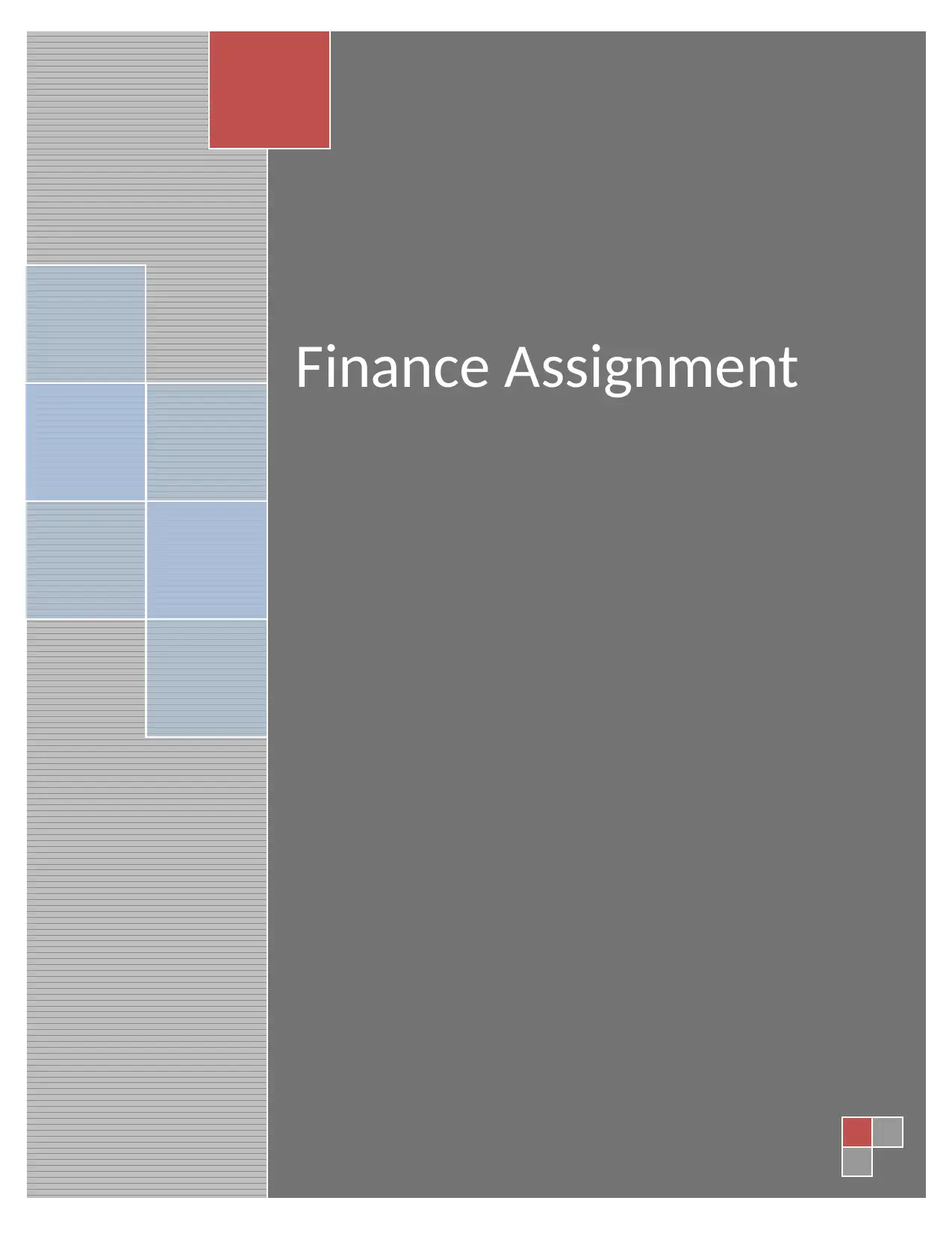
Finance Assignment
Paraphrase This Document
Need a fresh take? Get an instant paraphrase of this document with our AI Paraphraser
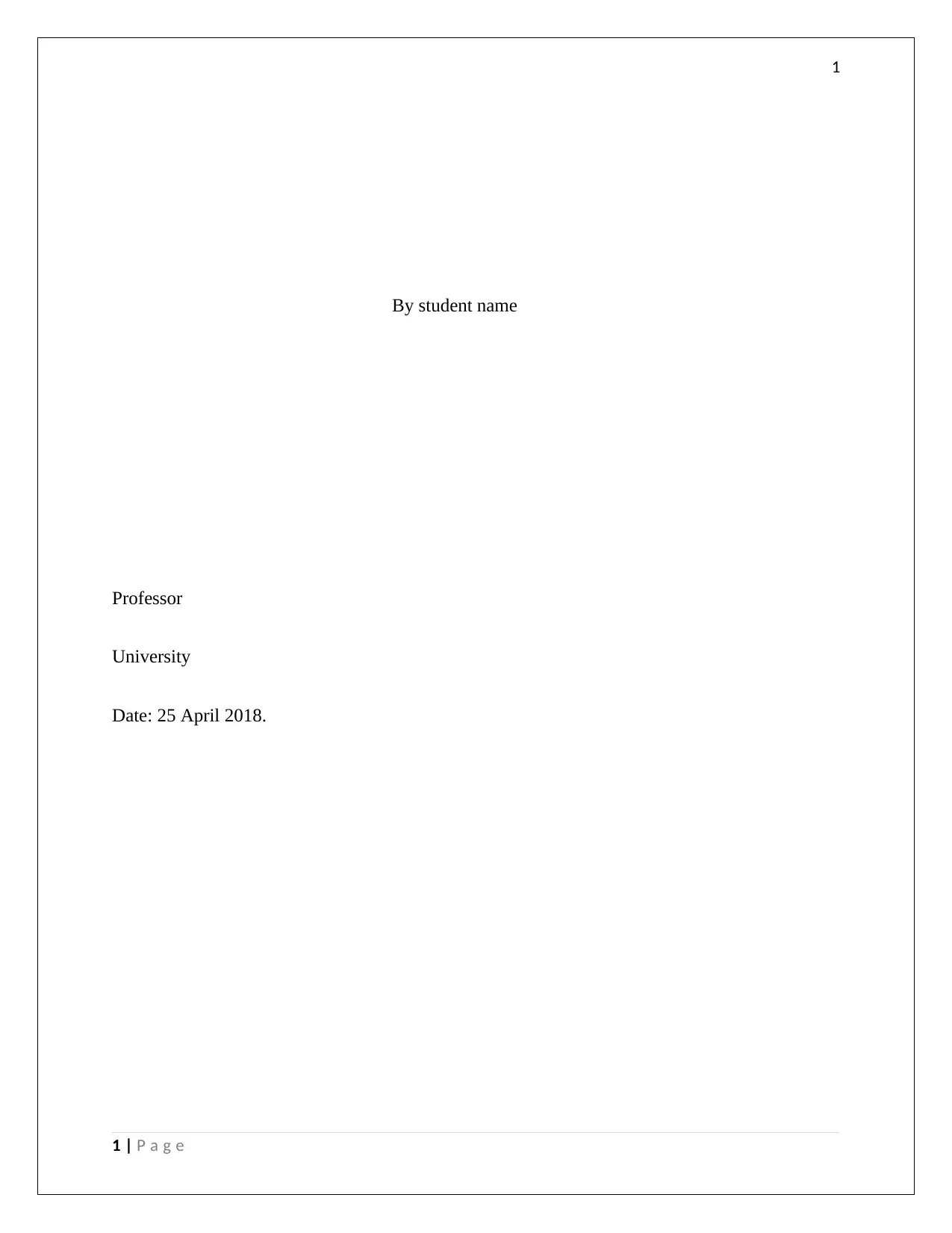
1
By student name
Professor
University
Date: 25 April 2018.
1 | P a g e
By student name
Professor
University
Date: 25 April 2018.
1 | P a g e

2
Contents
Section 1......................................................................................................................................................3
References...................................................................................................................................................5
2 | P a g e
Contents
Section 1......................................................................................................................................................3
References...................................................................................................................................................5
2 | P a g e
⊘ This is a preview!⊘
Do you want full access?
Subscribe today to unlock all pages.

Trusted by 1+ million students worldwide
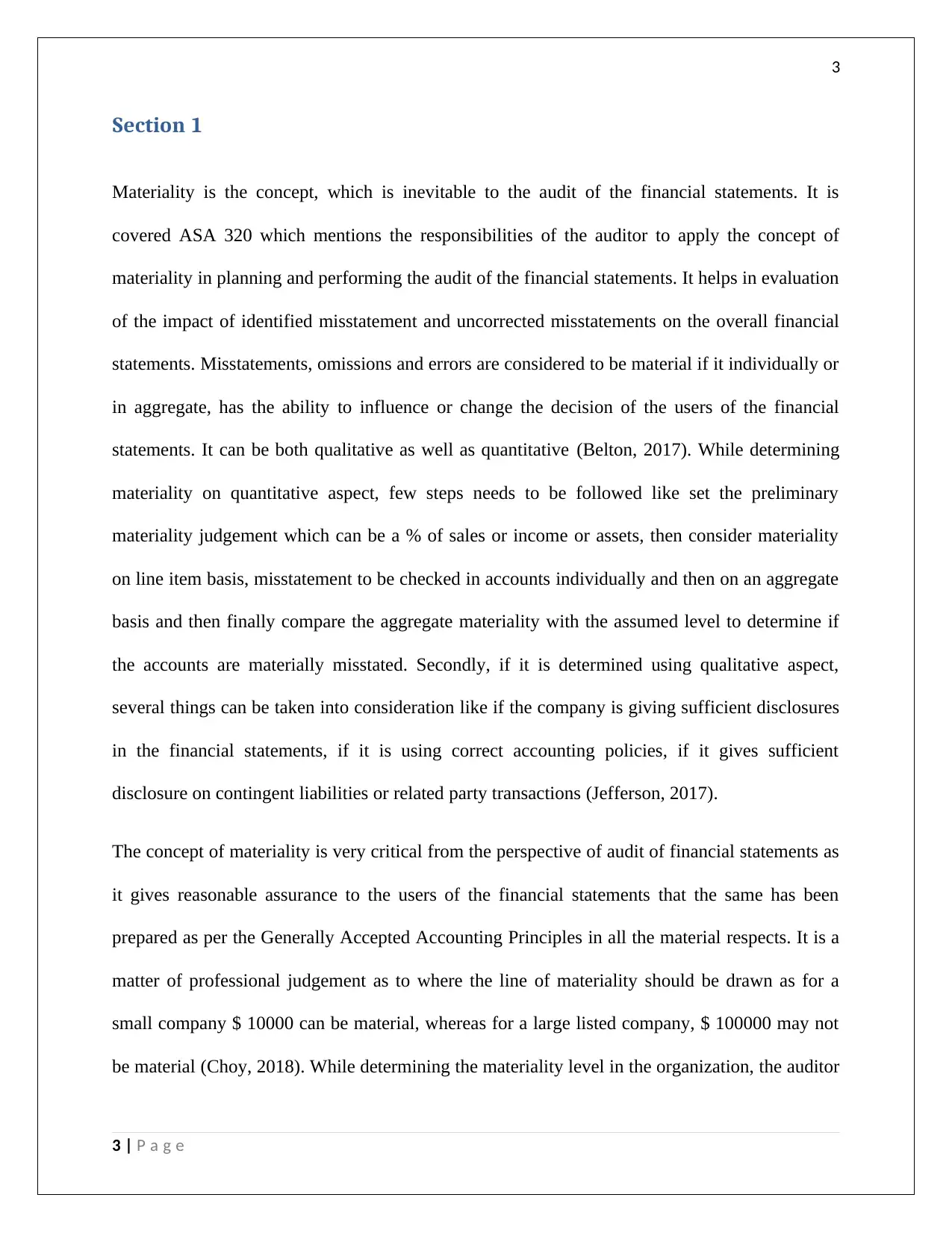
3
Section 1
Materiality is the concept, which is inevitable to the audit of the financial statements. It is
covered ASA 320 which mentions the responsibilities of the auditor to apply the concept of
materiality in planning and performing the audit of the financial statements. It helps in evaluation
of the impact of identified misstatement and uncorrected misstatements on the overall financial
statements. Misstatements, omissions and errors are considered to be material if it individually or
in aggregate, has the ability to influence or change the decision of the users of the financial
statements. It can be both qualitative as well as quantitative (Belton, 2017). While determining
materiality on quantitative aspect, few steps needs to be followed like set the preliminary
materiality judgement which can be a % of sales or income or assets, then consider materiality
on line item basis, misstatement to be checked in accounts individually and then on an aggregate
basis and then finally compare the aggregate materiality with the assumed level to determine if
the accounts are materially misstated. Secondly, if it is determined using qualitative aspect,
several things can be taken into consideration like if the company is giving sufficient disclosures
in the financial statements, if it is using correct accounting policies, if it gives sufficient
disclosure on contingent liabilities or related party transactions (Jefferson, 2017).
The concept of materiality is very critical from the perspective of audit of financial statements as
it gives reasonable assurance to the users of the financial statements that the same has been
prepared as per the Generally Accepted Accounting Principles in all the material respects. It is a
matter of professional judgement as to where the line of materiality should be drawn as for a
small company $ 10000 can be material, whereas for a large listed company, $ 100000 may not
be material (Choy, 2018). While determining the materiality level in the organization, the auditor
3 | P a g e
Section 1
Materiality is the concept, which is inevitable to the audit of the financial statements. It is
covered ASA 320 which mentions the responsibilities of the auditor to apply the concept of
materiality in planning and performing the audit of the financial statements. It helps in evaluation
of the impact of identified misstatement and uncorrected misstatements on the overall financial
statements. Misstatements, omissions and errors are considered to be material if it individually or
in aggregate, has the ability to influence or change the decision of the users of the financial
statements. It can be both qualitative as well as quantitative (Belton, 2017). While determining
materiality on quantitative aspect, few steps needs to be followed like set the preliminary
materiality judgement which can be a % of sales or income or assets, then consider materiality
on line item basis, misstatement to be checked in accounts individually and then on an aggregate
basis and then finally compare the aggregate materiality with the assumed level to determine if
the accounts are materially misstated. Secondly, if it is determined using qualitative aspect,
several things can be taken into consideration like if the company is giving sufficient disclosures
in the financial statements, if it is using correct accounting policies, if it gives sufficient
disclosure on contingent liabilities or related party transactions (Jefferson, 2017).
The concept of materiality is very critical from the perspective of audit of financial statements as
it gives reasonable assurance to the users of the financial statements that the same has been
prepared as per the Generally Accepted Accounting Principles in all the material respects. It is a
matter of professional judgement as to where the line of materiality should be drawn as for a
small company $ 10000 can be material, whereas for a large listed company, $ 100000 may not
be material (Choy, 2018). While determining the materiality level in the organization, the auditor
3 | P a g e
Paraphrase This Document
Need a fresh take? Get an instant paraphrase of this document with our AI Paraphraser
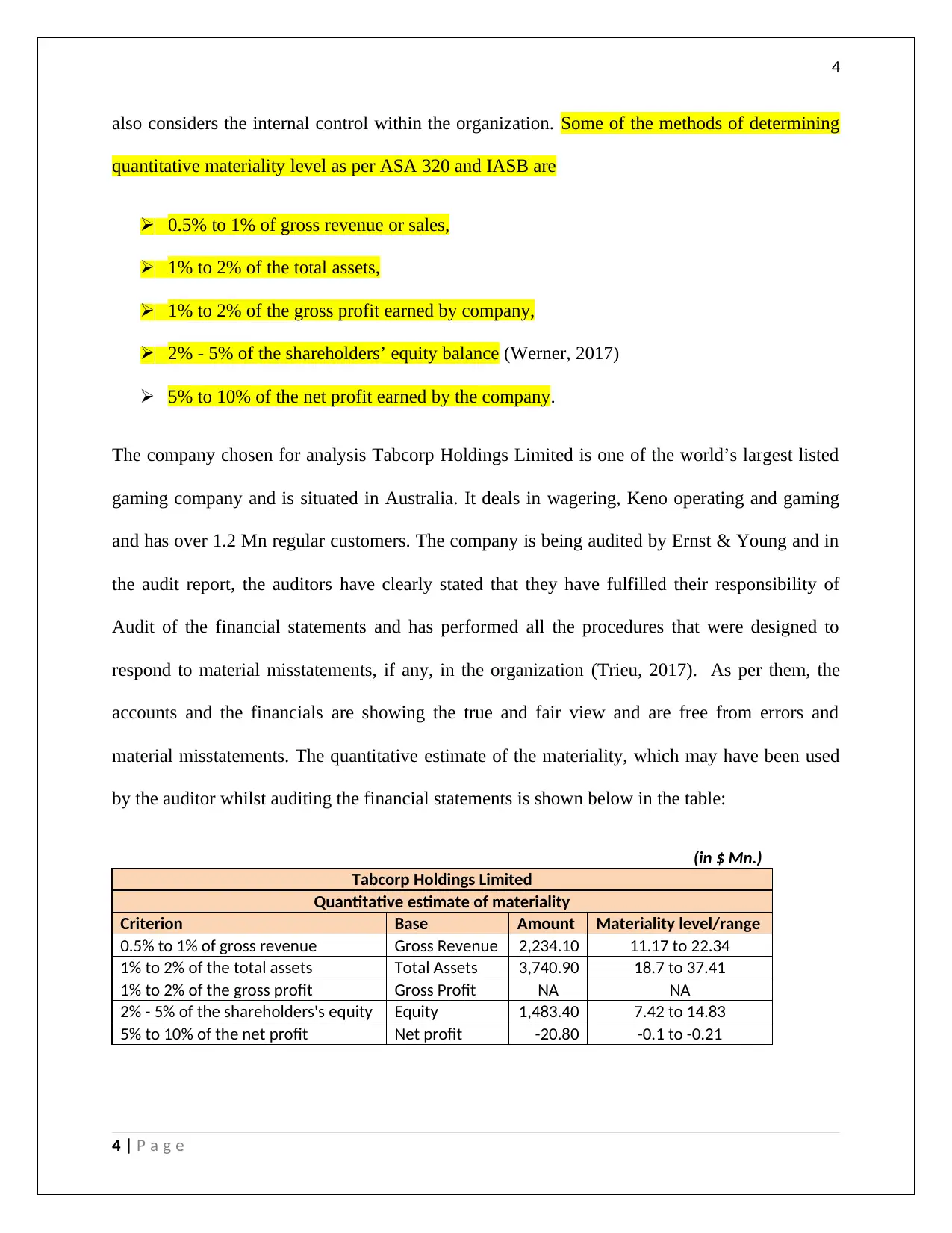
4
also considers the internal control within the organization. Some of the methods of determining
quantitative materiality level as per ASA 320 and IASB are
0.5% to 1% of gross revenue or sales,
1% to 2% of the total assets,
1% to 2% of the gross profit earned by company,
2% - 5% of the shareholders’ equity balance (Werner, 2017)
5% to 10% of the net profit earned by the company.
The company chosen for analysis Tabcorp Holdings Limited is one of the world’s largest listed
gaming company and is situated in Australia. It deals in wagering, Keno operating and gaming
and has over 1.2 Mn regular customers. The company is being audited by Ernst & Young and in
the audit report, the auditors have clearly stated that they have fulfilled their responsibility of
Audit of the financial statements and has performed all the procedures that were designed to
respond to material misstatements, if any, in the organization (Trieu, 2017). As per them, the
accounts and the financials are showing the true and fair view and are free from errors and
material misstatements. The quantitative estimate of the materiality, which may have been used
by the auditor whilst auditing the financial statements is shown below in the table:
(in $ Mn.)
Tabcorp Holdings Limited
Quantitative estimate of materiality
Criterion Base Amount Materiality level/range
0.5% to 1% of gross revenue Gross Revenue 2,234.10 11.17 to 22.34
1% to 2% of the total assets Total Assets 3,740.90 18.7 to 37.41
1% to 2% of the gross profit Gross Profit NA NA
2% - 5% of the shareholders's equity Equity 1,483.40 7.42 to 14.83
5% to 10% of the net profit Net profit -20.80 -0.1 to -0.21
4 | P a g e
also considers the internal control within the organization. Some of the methods of determining
quantitative materiality level as per ASA 320 and IASB are
0.5% to 1% of gross revenue or sales,
1% to 2% of the total assets,
1% to 2% of the gross profit earned by company,
2% - 5% of the shareholders’ equity balance (Werner, 2017)
5% to 10% of the net profit earned by the company.
The company chosen for analysis Tabcorp Holdings Limited is one of the world’s largest listed
gaming company and is situated in Australia. It deals in wagering, Keno operating and gaming
and has over 1.2 Mn regular customers. The company is being audited by Ernst & Young and in
the audit report, the auditors have clearly stated that they have fulfilled their responsibility of
Audit of the financial statements and has performed all the procedures that were designed to
respond to material misstatements, if any, in the organization (Trieu, 2017). As per them, the
accounts and the financials are showing the true and fair view and are free from errors and
material misstatements. The quantitative estimate of the materiality, which may have been used
by the auditor whilst auditing the financial statements is shown below in the table:
(in $ Mn.)
Tabcorp Holdings Limited
Quantitative estimate of materiality
Criterion Base Amount Materiality level/range
0.5% to 1% of gross revenue Gross Revenue 2,234.10 11.17 to 22.34
1% to 2% of the total assets Total Assets 3,740.90 18.7 to 37.41
1% to 2% of the gross profit Gross Profit NA NA
2% - 5% of the shareholders's equity Equity 1,483.40 7.42 to 14.83
5% to 10% of the net profit Net profit -20.80 -0.1 to -0.21
4 | P a g e
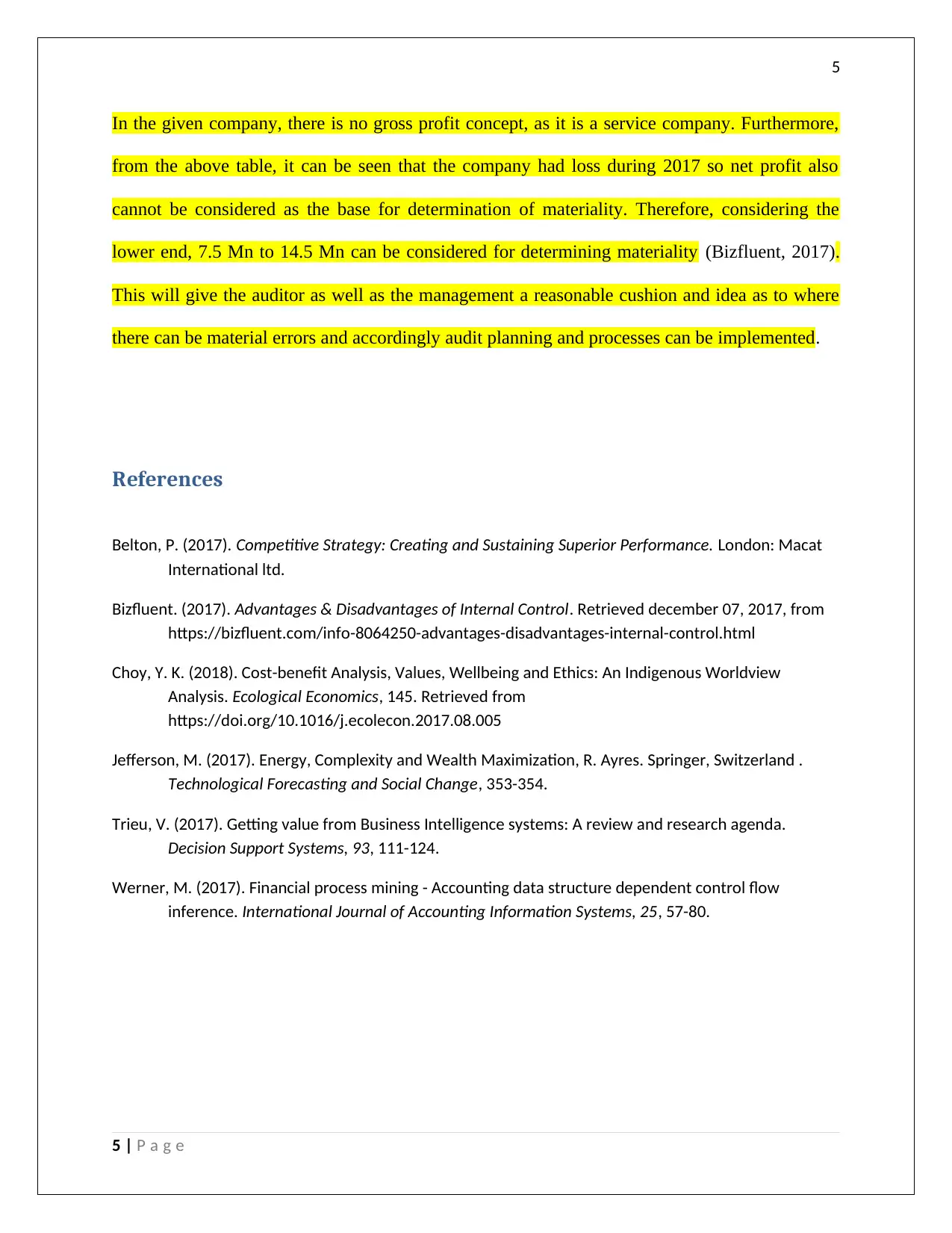
5
In the given company, there is no gross profit concept, as it is a service company. Furthermore,
from the above table, it can be seen that the company had loss during 2017 so net profit also
cannot be considered as the base for determination of materiality. Therefore, considering the
lower end, 7.5 Mn to 14.5 Mn can be considered for determining materiality (Bizfluent, 2017).
This will give the auditor as well as the management a reasonable cushion and idea as to where
there can be material errors and accordingly audit planning and processes can be implemented.
References
Belton, P. (2017). Competitive Strategy: Creating and Sustaining Superior Performance. London: Macat
International ltd.
Bizfluent. (2017). Advantages & Disadvantages of Internal Control. Retrieved december 07, 2017, from
https://bizfluent.com/info-8064250-advantages-disadvantages-internal-control.html
Choy, Y. K. (2018). Cost-benefit Analysis, Values, Wellbeing and Ethics: An Indigenous Worldview
Analysis. Ecological Economics, 145. Retrieved from
https://doi.org/10.1016/j.ecolecon.2017.08.005
Jefferson, M. (2017). Energy, Complexity and Wealth Maximization, R. Ayres. Springer, Switzerland .
Technological Forecasting and Social Change, 353-354.
Trieu, V. (2017). Getting value from Business Intelligence systems: A review and research agenda.
Decision Support Systems, 93, 111-124.
Werner, M. (2017). Financial process mining - Accounting data structure dependent control flow
inference. International Journal of Accounting Information Systems, 25, 57-80.
5 | P a g e
In the given company, there is no gross profit concept, as it is a service company. Furthermore,
from the above table, it can be seen that the company had loss during 2017 so net profit also
cannot be considered as the base for determination of materiality. Therefore, considering the
lower end, 7.5 Mn to 14.5 Mn can be considered for determining materiality (Bizfluent, 2017).
This will give the auditor as well as the management a reasonable cushion and idea as to where
there can be material errors and accordingly audit planning and processes can be implemented.
References
Belton, P. (2017). Competitive Strategy: Creating and Sustaining Superior Performance. London: Macat
International ltd.
Bizfluent. (2017). Advantages & Disadvantages of Internal Control. Retrieved december 07, 2017, from
https://bizfluent.com/info-8064250-advantages-disadvantages-internal-control.html
Choy, Y. K. (2018). Cost-benefit Analysis, Values, Wellbeing and Ethics: An Indigenous Worldview
Analysis. Ecological Economics, 145. Retrieved from
https://doi.org/10.1016/j.ecolecon.2017.08.005
Jefferson, M. (2017). Energy, Complexity and Wealth Maximization, R. Ayres. Springer, Switzerland .
Technological Forecasting and Social Change, 353-354.
Trieu, V. (2017). Getting value from Business Intelligence systems: A review and research agenda.
Decision Support Systems, 93, 111-124.
Werner, M. (2017). Financial process mining - Accounting data structure dependent control flow
inference. International Journal of Accounting Information Systems, 25, 57-80.
5 | P a g e
⊘ This is a preview!⊘
Do you want full access?
Subscribe today to unlock all pages.

Trusted by 1+ million students worldwide
1 out of 6
Related Documents
Your All-in-One AI-Powered Toolkit for Academic Success.
+13062052269
info@desklib.com
Available 24*7 on WhatsApp / Email
![[object Object]](/_next/static/media/star-bottom.7253800d.svg)
Unlock your academic potential
Copyright © 2020–2025 A2Z Services. All Rights Reserved. Developed and managed by ZUCOL.





